Are you tired of the endless work of maintaining a natural lawn? The constant mowing, watering, and weeding eat up your time and money, leaving you with patchy results.
People choose artificial grass for its low maintenance, durability, and year-round green appearance. It saves water, eliminates the need for pesticides, and withstands heavy use far better than natural grass, making it a practical and cost-effective solution for many homes and businesses.
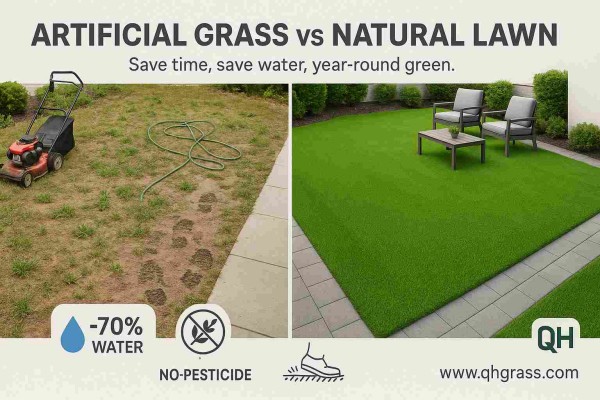
It’s clear why so many people are making the switch. The benefits are very compelling. From my years as an engineer in this industry, I’ve seen the technology evolve to solve real-world problems for homeowners and businesses. But making a smart decision means looking at the entire picture, not just the highlights. I get a lot of questions from customers who are considering artificial turf for the first time. Let’s walk through some of the most common ones. Answering these will help you understand if artificial grass is truly the right choice for your project.
What is the downside of artificial grass?
Worried that artificial grass seems too good to be true? You are right to be cautious about the potential drawbacks before making a decision.
The main downsides are the initial installation cost1, which is higher than seeding natural grass, and heat retention2. On hot, sunny days, the surface can get warmer than natural grass. Also, some lower-quality products can look less realistic.
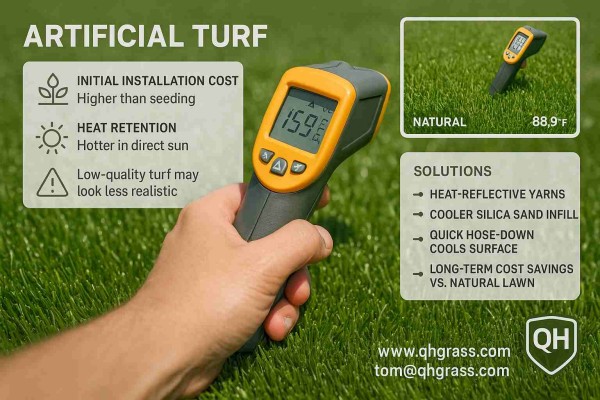
Let’s break these points down further. It’s important to have a balanced view.
The Initial Cost
The upfront cost is often the first thing people notice. Yes, installing a quality artificial grass system is more expensive at the start than planting natural grass seed. However, I always advise my clients to think about the total cost over several years3. A natural lawn is a constant expense. You have to pay for water, fertilizer, pesticides, and lawnmower fuel. You might also need to pay for a landscaping service. Artificial grass eliminates nearly all of those ongoing costs. When you compare the expenses over 5 or 10 years, artificial grass often comes out cheaper.
| Feature | Artificial Grass | Natural Grass (5-Year Estimate) |
|---|---|---|
| Initial Cost | High | Low |
| Water Bills | Almost None | High and Recurring |
| Mowing/Maintenance | Almost None | Regular Expense |
| Fertilizers/Weedkiller | None | Regular Expense |
| Total Investment | Lower over time | Higher over time |
Surface Temperature
The surface of artificial grass can get hot in direct, intense sunlight. This is a valid concern, especially for families with children and pets. However, technology has provided solutions. Many modern turf products are made with heat-reflective yarns that stay cooler. The type of infill used also makes a big difference. Some infills, like rounded silica sand, retain less heat than others. On the hottest days, a quick spray with a garden hose can cool the surface down instantly. It’s a manageable issue, not a deal-breaker.
Can rain get through artificial grass?
Are you concerned about puddles forming on your new lawn? A waterlogged yard can be a huge mess and ruin your investment.
Yes, rain gets through artificial grass easily and effectively. Quality turf is manufactured with a perforated backing that allows water to pass through. This water then drains away through the specially prepared sub-base underneath, preventing puddles.
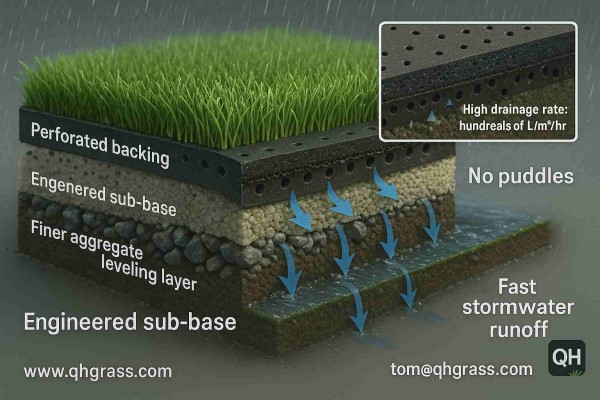
The drainage capability is one of the most important technical aspects of an artificial grass system. It’s something I spent years perfecting in the workshop. It’s not just about the grass itself; it’s about the entire installation from the ground up.
The Backing and Drainage Holes
Every roll of quality artificial turf has a backing system. This backing is typically coated with polyurethane or latex to lock the fibers in place. During the manufacturing process, we punch small, evenly spaced holes through this backing. These are the drainage perforations. When it rains, water hits the grass fibers, drips down onto the backing, and passes straight through these holes. The number and size of these holes determine the drainage rate, which is a key quality indicator I always check. A good product can drain hundreds of liters of water per square meter every hour.
The Sub-Base is Key
The turf is only the top layer of the system. The real work of drainage happens in the sub-base that lies beneath it. A professional installation involves excavating the area and laying down a foundation of crushed rock and finer aggregates. This creates a stable and highly permeable layer. Water passes through the turf’s drainage holes and into this sub-base, where it can then drain away naturally into the ground below. I once saw a project fail because the installer laid turf directly on compacted soil. The first heavy rain created a muddy swamp because the water had nowhere to go. This is why a proper sub-base is not optional; it is essential for performance.
Does artificial grass need to be washed?
You chose artificial grass for low maintenance, but does it get dirty? You’re right to wonder about cleaning, especially with kids, pets, or outdoor dining.
Yes, artificial grass needs occasional washing, but it’s very simple. A light rinse with a hose removes dust and pollen. For spills or pet messes, you can use mild soap and water. Regular, easy cleaning is all it takes.
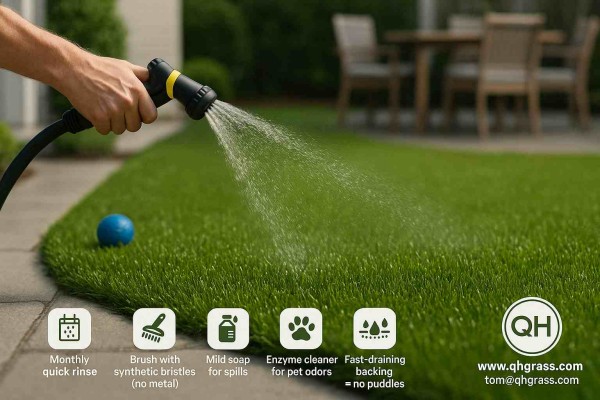
"Low maintenance" should not mean "no maintenance." Keeping your lawn clean is easy and ensures it looks great and lasts a long time. Here’s how I advise my clients to care for their investment.
Routine Cleaning
For general upkeep, I recommend a quick rinse with a garden hose once a month, or more often if you live in a dusty area. This washes away airborne dust, pollen, and leaves. It keeps the color looking vibrant. After a rinse, you can use a stiff brush with synthetic bristles (never use a metal brush, as it will damage the fibers) to gently brush the grass blades. Brushing against the grain helps the fibers stand up, which is especially important in areas with high foot traffic. This simple step keeps the grass looking full and natural.
Dealing with Spills and Pets
Accidents happen. If you spill a drink, just blot it up and rinse the area with water. For sticky spills, a little dish soap in water works perfectly. For pet owners, artificial grass is a fantastic solution. Solid waste can be picked up just like on any other surface. After that, a quick rinse will wash away any residue. The excellent drainage system prevents urine from creating puddles or smells. If you do notice an odor over time, there are specialized enzyme cleaners that safely break down the bacteria and eliminate the smell completely. Many of my customers with dogs tell me it’s one of the best decisions they’ve made.
How long does artificial grass last?
Investing in a new lawn is a big decision. You need to be confident about how long your investment will last.
A high-quality artificial grass installation can last 15 to 20 years, or even longer. Its lifespan depends on the quality of the materials, the amount of foot traffic it endures, and how well it is maintained over time.
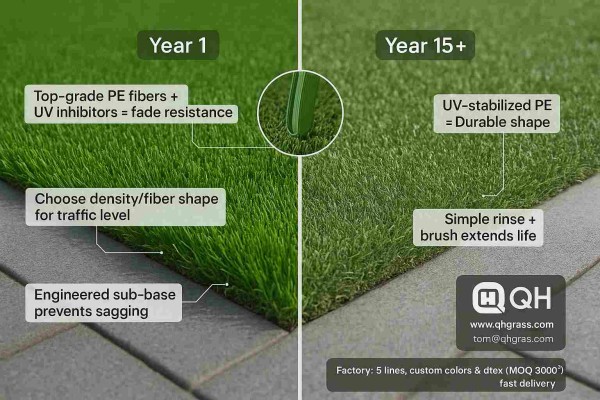
As an engineer, durability is always at the top of my mind. A product’s lifespan is a direct measure of its quality and value. When I help customers choose a product, we always discuss three main factors that determine how long their new lawn will last.
Material Quality and UV Protection
The materials used to make the grass fibers are critical. Most landscaping turf is made from Polyethylene (PE) because it is soft and looks realistic. The real key to longevity, however, is the UV stabilization package mixed into the plastic. Without strong UV inhibitors, the sun’s rays will break down the fibers, causing them to fade and become brittle. At QH Grass, we use only top-grade raw materials with the best UV protection to ensure our products resist fading and remain durable for years, even in harsh climates.
Traffic and Usage
The purpose of the lawn matters. A small, decorative front yard that sees very little foot traffic will naturally last longer than a backyard that hosts daily soccer games. This is why we produce different types of turf. Products with a higher density and more durable fiber shape are designed for high-traffic areas like playgrounds and sports fields. Choosing the right product for your specific needs is essential for getting the best long-term performance.
Installation and Maintenance
Finally, even the best artificial grass will fail if it’s installed improperly. A solid, well-draining sub-base is the foundation for a long-lasting lawn. It prevents sagging, ripples, and drainage problems. Additionally, the simple maintenance I mentioned earlier—regular rinsing and brushing—will significantly extend the life of your turf by keeping it clean and the fibers upright.
Conclusion
Artificial grass offers a beautiful, durable, and low-effort solution. By understanding the key details, you can make a smart investment that provides enjoyment and value for many years.
-
Understanding the upfront costs can help you budget effectively for your landscaping project. ↩
-
Learn about heat retention to make informed decisions for your outdoor space, especially in hot climates. ↩
-
This analysis can help you see the long-term savings of artificial grass versus natural lawns. ↩
_画板-1.png)
_画板-1.png)